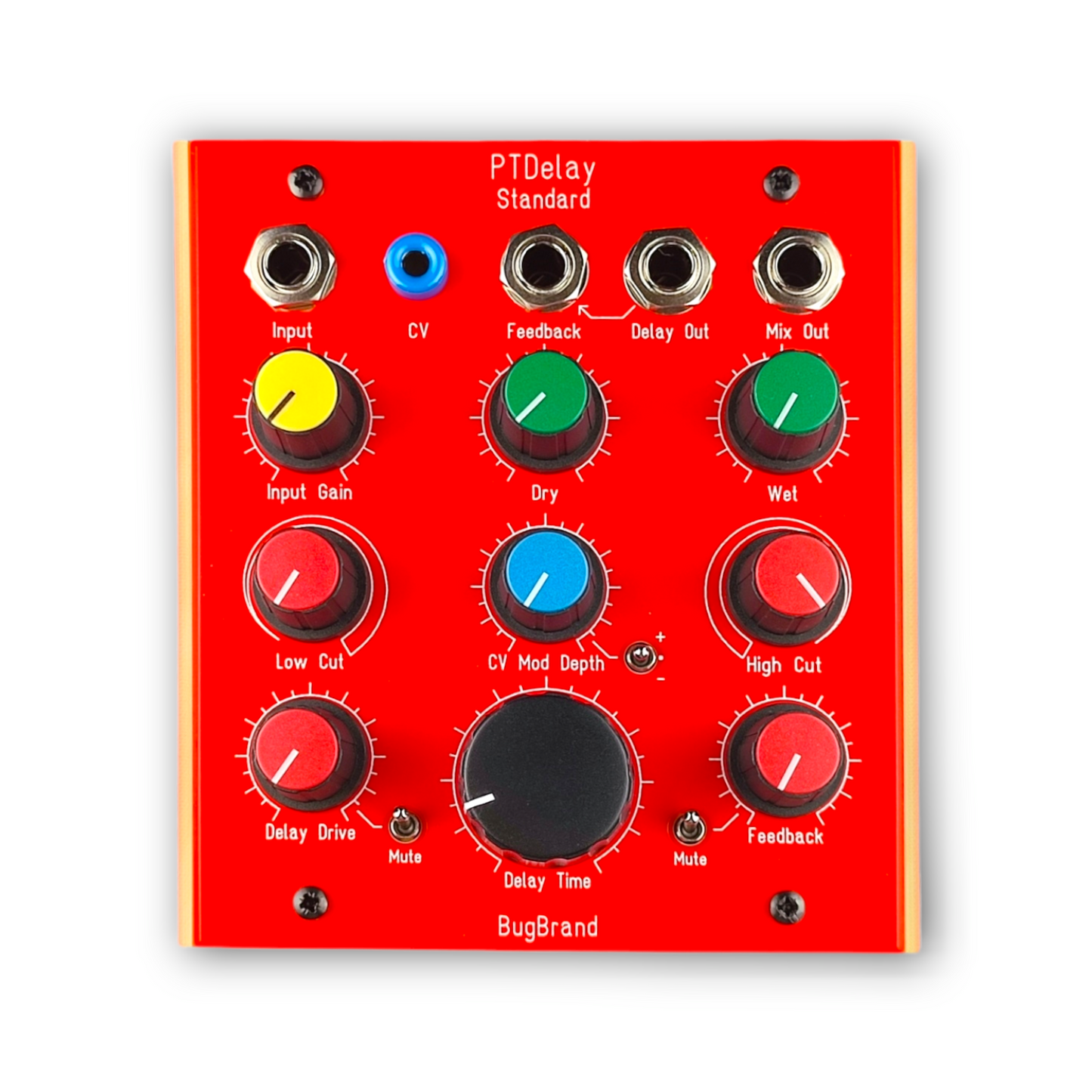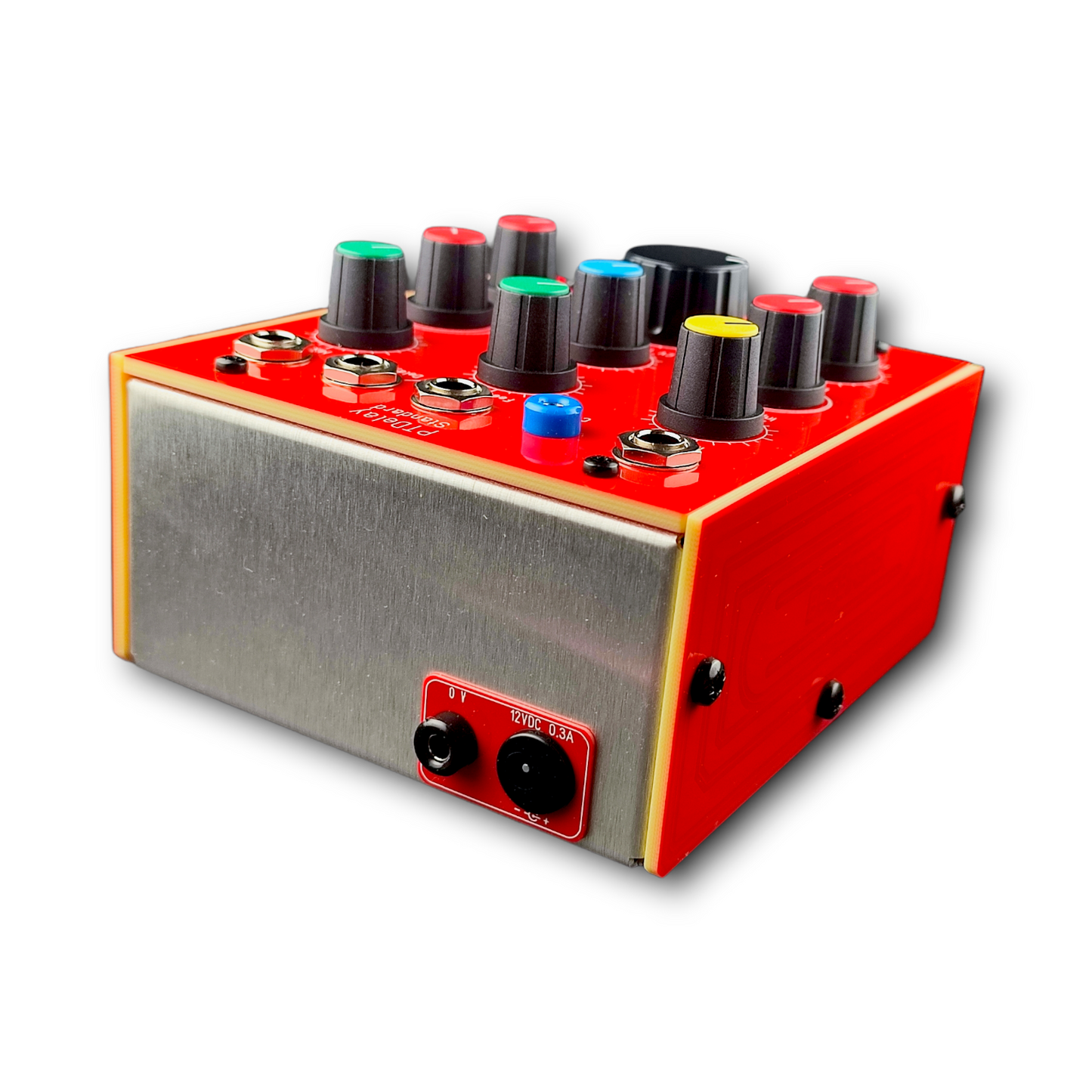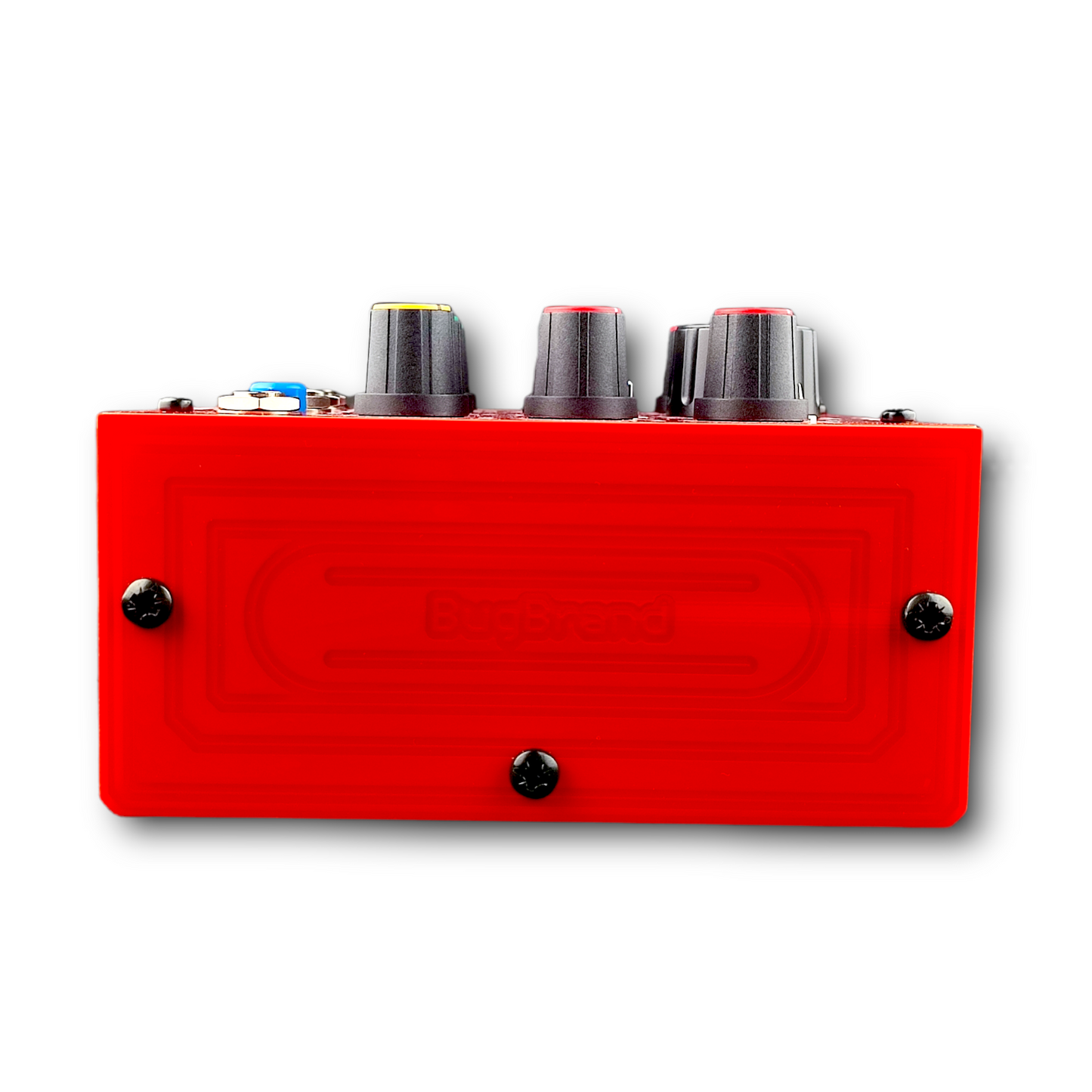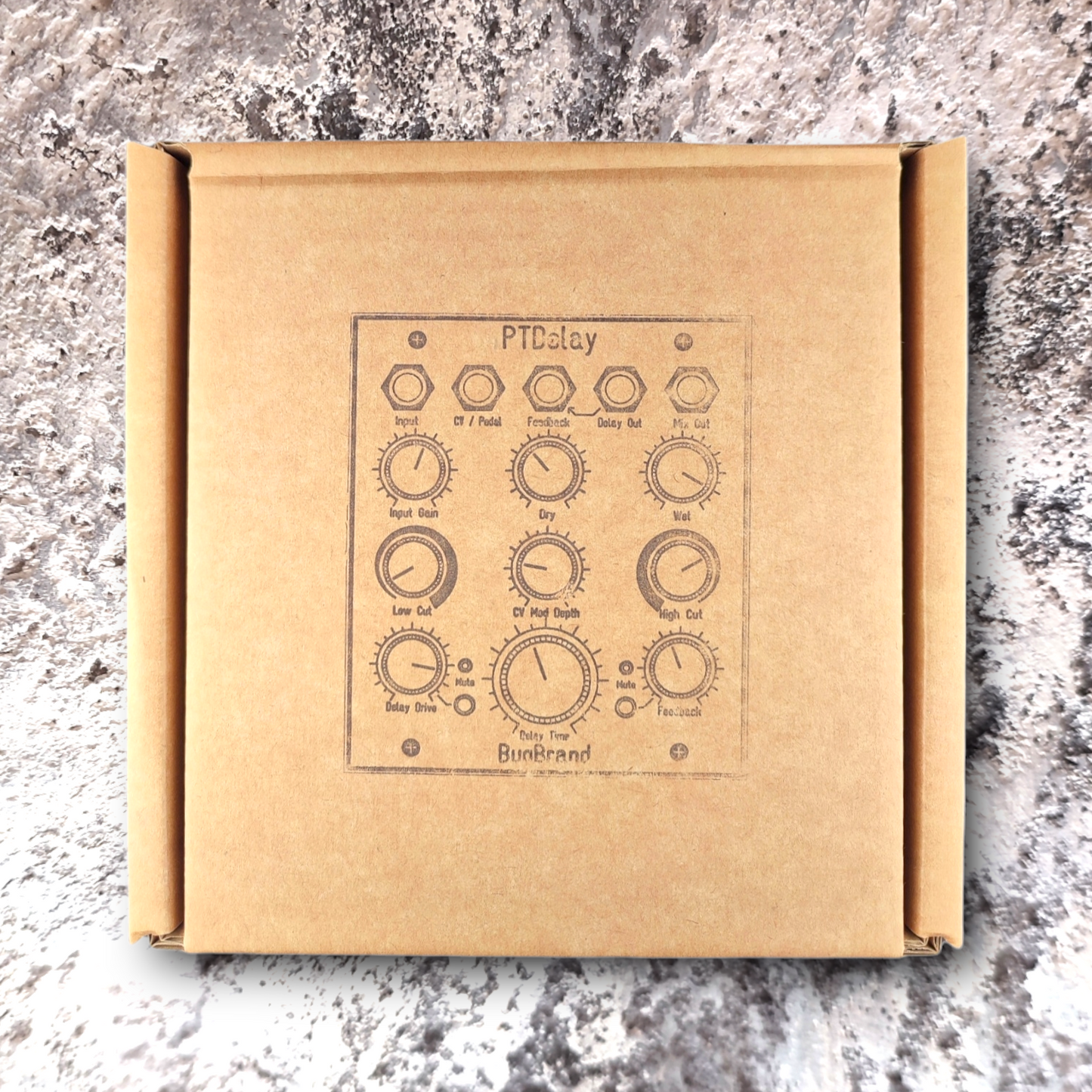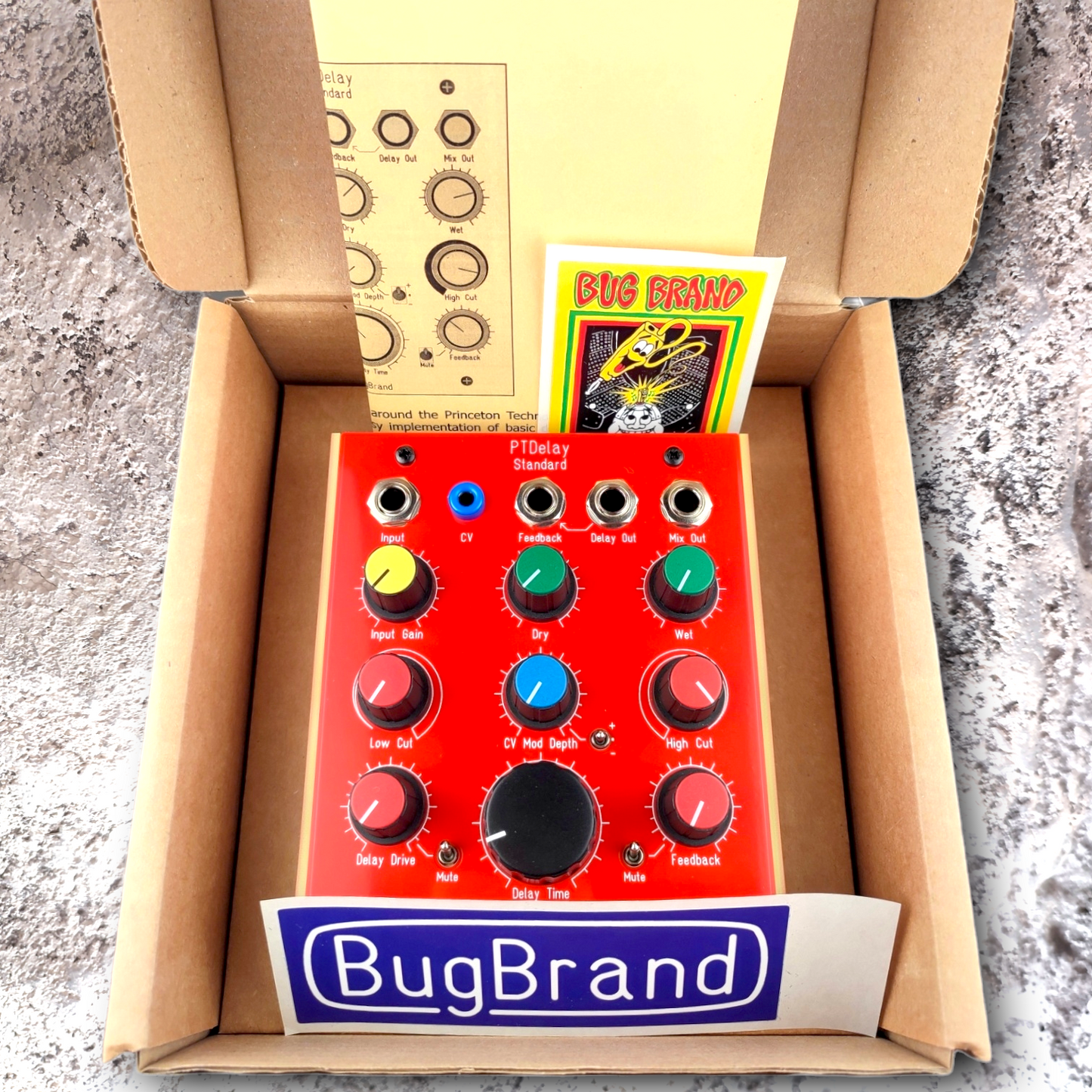BugBrand
PTDelay
PTDelay
Couldn't load pickup availability
by Bugbrand
Happy to have these In stock and shipping immediately.
(German text below)
Text by Tom Bugs
The PT Delay is a highly characterful delay processor built around the infamous PT2399 chip. It does not aim to compete with clever modern delays (so no microprocessor, tap-tempo, beat-sync, etc.) and instead presents a unique hands-on affair for textural sonic play. With soft-clipping stages, voltage-controlled delay time, powerful equalisation and a true analogue approach, the PT Delay can produce tones akin to tape delays or gnarl down into degraded digital territories. Stand distinct! The first PT Delay was released in 2011. When I decided to tweak the design 'just a bit' it ended up taking many months and 10+ prototypes to reach the next stage, but, arriving in mid-2013, the (original) PT Delay Standard ushered in a new era as the first of my 'red module' format designs.
Input Section: Designed for typical line level signals with variable amplification up to 20dB. The input features the first of three LED saturation / soft-clip stages - these stages aim to keep internal signal levels to a standardised level so that, for example, overloading the feedback doesn't cause dramatic level changes (instead it overloads into sonic wonders, but without the amplitude running crazy). These clip stages can definitely be used for creative explorations.
Delay Drive / Feedback: Two controls to determine what goes into the Delay Core, each with Mute switch. The Delay Drive allows bursts of the input sound to be thrown in in true dub-style, while the Feedback (normalised from Delay Out) takes you from single repeat, through washy feedback and into overload.
Voltage Controlled Delay Core: Delay time is set by a combination of the main Delay Time dial summed with any external Control Voltage (CV) from the CV Input and polarizing CV Mod Depth control. The main control covers times from 35mS to 2.5S, but external CV can take the time longer (up to total digital jittery stop). Delays up to about 300mS (around 1 o'clock on the main dial) are quite clean and from there the digital artefacts start to increase.
The 4mm banana CV input is designed for signals from sources such as Modular Synths (typical 5 to 10V p-to-p levels) - the response is not 1V/Oct for sure!
EQ: Low and High cut filtering (identical to on the PEQ) follows the Delay core - tonally shaping the signals and resulting feedback behaviour.
Output Section: The main output comes from a mix of Dry and Delayed (Wet) signals. There is also an output of just the Delayed signal which is normalised to the Feedback input - you can insert further external processing here to alter feedback behaviours.
Technical Specifications:
Input - Mono unbalanced 1/4" Jack - impedance 66k Ohms
Outputs - Mono Impdeance-balanced 1/4" Jack - impedance 680 Ohms
CV - 4mm Banana - impedance 100k Ohms
Power - 12V DC 500mA supply, centre-positive, 2.1mm connector.
(worldwide 90-240VAC wall-wart provided with interchangeable mains plug adaptors)
The PTDelay is enclosed in a custom aluminium case (based on the Modular line) with PCB material front and side panels.
Dimensions approx 5.25" x 5" x 3.5"
Two year parts warranty.
With Universal PSU.
NOTE ->IF YOUR COUNTRY SEEMS LIKE A TOO HIGH PRICE< PLEASE CONTACT ME< AND I CAN DOUBLE CHECK THAT YOUR COUNTRY HAS THE CORRECT SHIPPING PRICE >>
Das PT Delay ist ein sehr charaktervoller Delay-Prozessor, der auf dem berüchtigten PT2399 Chip basiert. Es soll sich nicht mit den cleveren modernen Delays und ihren Microprozessoren, Tap-Tempo oder Beat-Sync Funktionen messen, sondern eine spezielle, direkte und spielerische Angelegenheit bieten, mit musikalischen Texturen zu arbeiten. Mit Soft-Clipping Stufen, durch Steuerspannung regulierbarer Delay-Zeit, leistungsstarkem Equalizer und einem wahren analogen Ansatz, kann das PT Delay Klangwelten produzieren, die zwischen denen von Tape Delays auf der einen, und erodierten Digital-Sounds auf der anderen Seite changieren.
Das erste PT Delay wurde 2011 veröffentlicht. Aus meinem Vorhaben, das Design „ein klein wenig“ zu verändern, sollten Monate werden, zehn und mehr Prototypen waren vonnöten, um die nächste Stufe zu erreichen. Mitte 2013 dann war das ursprüngliche PT Delay Standard fertig und führte in die neue Ära meiner „Red Module“ Designs ein – um 2015/16 und 2018 weitere Male überarbeitet zu werden. (Das „Standard“ im Namen deutet an, dass ich vielleicht eines Tages eine „Deluxe“ Version veröffentlichen werde. Bleibt abzuwarten.)
Die Updates der Version von 2018:
-
der 6.3mm Input ist nun balanced (kann aber selbstverständlich auch unbalanced verwendet werden)
-
der CV-Regler hat nun einen Schalter: man kann die Polarität ändern, der Nullpunkt befindet sich in der Mitte
-
generelle Verbesserungen der Schaltung
Input-Bereich: Designt für typische Line-Level Signale mit variabler Verstärkung bis zu 20db. Der Input ist mit der ersten von drei LED Sättigungs-/Soft-Clip-Stufen ausgestattet. Diese Stufen sorgen dafür, dass die internen Signale ein standardisiertes Niveau nicht überschreiten, so dass übersteuertes Feedback beispielsweise das Level nicht drastisch verändert (sondern klangliche Wunder hervorbringt, ohne die Amplitude durchdrehen zu lassen). Diese Clip Stufen können definitiv für kreative Erkundungen fruchtbar gemacht werden.
Delay Drive / Feedback: Zwei Regler, die darüber bestimmen, was dem Delay Core zugefügt wird, jeder ausgestattet mit eigenem Mute-Schalter. Der Delay Drive erlaubt den Einwurf von Sound-Ausbrüchen im true Dub-Style, während einen das Feedback (normalisiert vom Delay Out) von der einzelnen Wiederholung über verwaschenes Feedback hin zum Overload nimmt.
Voltage Controlled Delay Core: Die Delay Zeit ist bestimmt durch die Summe des Delay Time Reglers und jeder zugeführten Steuerspannung, die mithilfe des CV Mod Depth und dem Polarity-Schalter justiert werden kann. Der Hauptregler deckt Zeiten von 35 Millisekunden bis 2 Sekunden ab, externe Steuerspannungen können die Zeit verlängern (bis hin zum Digital Jittery Stop). Delays bis zu etwa 300 Millisekunden (ungefähr 1-Uhr-Position des Hauptschalters) sind ziemlich clean, dann mehren sich die Digitalen Artefakte.
Die 4 Millimeter Bananensteckerbuchse ist designt für die Verbindung von Signalquellen wie Modular Synths (typischerweise 5 bis 10 Volt) – und die Response ist sicherlich nicht 1V/Okt!
EQ: Low- und High-cut Filtering (dem PEQ identisch) folgen dem Delay-Kern und formen die Signale wie auch das Feedback-Verhalten.
Output Section: Das Signal am Hauptausgang ist eine Mischung der Dry und Delayed (Wet) Signale. Außerdem ist ein Output vorhanden, der nur das Wet-Signal ausgibt und mit dem Feedback-Eingang verbunden ist. An dieser Stelle lässt sich weiteres externes Processing einfügen zur Veränderung des Feedback-Verhaltens.
Technische Spezifikationen:
Input - Mono balanced 6,3mm Stecker - Impedanz 20k Ohm
Outputs - Mono Impedance-balanced 6,3mm Stecker - Impedanz 100 Ohm
CV - 4mm Banana - Impedanz 100k Ohm
Strom - 12V DC 300mA supply, centre-positive, 2.1mm connector.
(internationale 90-240VAC Stromversorgung mit austauschbaren Adaptern inklusive)
Das PT Delay ist in ein Aluminiumgehäuse (basierend auf der Modular Linie) eingefasst, mit Front- und Seitenteilen aus PCB-Material. Es ist ein „Modul“ und kann problemlos in das modulare System eingefügt werden. Maße etwa 13,3cm x 12,7cm x 8,9cm.
